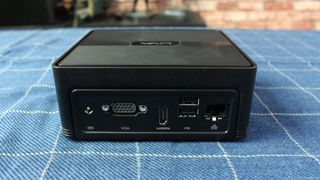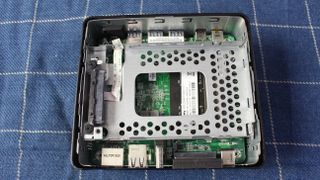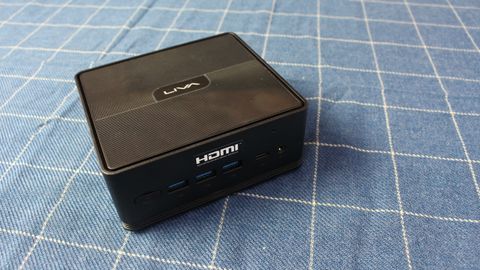TechRadar Verdict
This tiny PC is great to hide away as a simple PC for powering signage, but anything more taxing will start to slow it down.
Pros
- +
Quiet operation
- +
Compact size
Cons
- -
Slow internal storage
- -
8GB of RAM can be limiting
Why you can trust TechRadar
While PCs tend to conjure up images of bulky boxes, there are also smaller and more compact types that are perfect for when you need just a small amount of processing power. The ECS LIVA Z2V is one such gem, with a small palm-sized footprint that’s perfect for all sort of uses.
Whether it’s powering digital signage, being used as a Point Of Sale system, or even as a compact web browsing station at a library, there are a multitude of uses for the Z2V.
Price and availability
Pricing for the ECS LIVA Z2V isn’t available just yet, but the company has said that it will be available in the market in the near future.
Here is the ECS LIVA Z2V configuration sent to TechRadar for review:
CPU: 1.1GHz Intel Pentium Silver N5000 Processor (quad-core, 4MB cache, up to 2.7GHz)
Graphics: Intel HD Graphics 605
Motherboard: ECS Proprietary
RAM: 4GB DDR4 (2,400MHz)
Storage: 64GB eMMC
Ports (front): 3 x USB-A 3.1 (Gen 1) , 1 x USB 3.1 Type-C (Gen 1), 1 x headphone jack
Ports (rear): 2 x USB-A 2.0, 1 x HDMI, 1x VGA, Ethernet
Connectivity: Intel Wireless-AC 3165 (802.11ac); Bluetooth 4.2
Size: 132 x 118 x 56.4 mm (W x D x H)
Design
The most obvious thing about the Z2V is just how compact it is. Measuring just 132 x 118 x 56.4mm, it’s small enough to tuck away even in the most difficult of spaces. It comes with a VESA bracket in the box, so it can easily be attached to the back of a monitor or TV, and pretty much forgotten about.
At the front you’ve got three USB 3.0 ports, as well as a USB-C connector and a headphone jack. The rear has ports for Gigabit Ethernet, USB 2.0, HDMI, VGA, and power.

To get to the Z2V’s internals, you have to unscrew the bottom four feet. While this can be done by hand, we found these to be initially screwed in very tightly, so you’ll need a screwdriver to get in the first time around. Once the base plate is off, you can get to the Z2V to insert up to 8GB of RAM, as well as a 2.5” HDD or SSD. There’s up to 64GB of onboard storage as well, which is just about enough to slip Windows onto, so if you need any additional space it’s worth installing a HDD or SSD.

Performance
For a machine this tiny, the Z2V does a decent job of handling tasks like basic web browsing, or displaying videos on loop. The onboard storage is painfully slow, so reading media files off it can be a bit cumbersome, and 4K videos regularly caused issues. When we swapped our Windows installation to an installed SSD, thing went much smoother, so if you’re only displaying HD or 720p content on the Z2V, you should be good – anything more demanding is going to need much faster storage.
Here’s how the ECS LIVA Z2V performed in our suite of benchmark tests:
CrystalDiskMark: 241 MB/s (Read), 166.1 MB/s (Write)
GeekBench: 1,776 (single-core); 5,748 (multi-core)
PCMark 8 (Home Test): 3,286 points
Running Office applications on the Z2V proved to be too much for it, even when running them off the SSD. The 8GB of RAM just isn’t enough to load these heavier applications, so you’ll be limited to only running Google applications via a non-Chrome browser, as even Chrome struggled with more than four tabs open.
What’s great about the Z2V is that it’s entirely fanless, making it great for use in hospitals or even as a thin client in an office environment. Ventilation grilles on the side and bottom of the unit ensures that the unit doesn’t overheat, and even when we left the Z2V playing video overnight, it was only warm to the touch.
Verdict
If you’re looking for a compact PC to display video loops or use as a thin client, the ECS LIVA Z2V will fit the bill easily. For anything heavier, you’re going to run into difficulties, as the Z2V isn’t designed to tackle intense programs. We would have liked to have at least 16GB of RAM to play around with, as the maximum of 8GB really limits the Z2V to what it can do.
A former IT & Marketing Manager turned full time Editor, Nick enjoys reviewing PC components, 3D Printers, projectors, and anything shiny and expensive. He can also be found baking up a storm in the kitchen, which we are more than happy to encourage.

I got a Dolby Atmos soundtrack mixing demo at Sony Pictures Studios, and now I know how Spider-Man sounds get made
Today's Wordle answer is the hardest this year, with an average score of 5.4, and 'Wordle 1037 X' is trending on Twitter – here's why it's so tough and what to do in future

JLab JBuds Lux ANC review: budget headphones that are all about that bass

